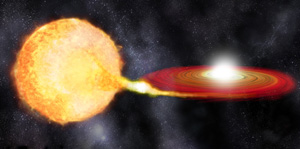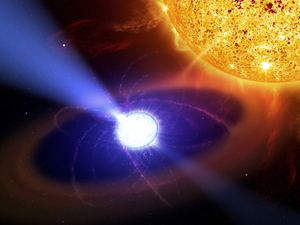 Some new research just released asks a question near and dear to me: are there thousands of spinning white dwarfs in our galaxy, just waiting to explode as they gradually slow their rotation?
Some new research just released asks a question near and dear to me: are there thousands of spinning white dwarfs in our galaxy, just waiting to explode as they gradually slow their rotation?
The answer is very probably yes. Let me be clear, as I always must be when covering topics like this: we’re not in any real danger from these things. Space is vast, and supernovae are few. If these things were that volatile we wouldn’t be here to talk about them in the first place.
But it’s still a very cool scientific question, and actually a fairly simple concept. Here’s how it works.
Imagine a binary system of two stars like the Sun, orbiting each other. One star nears the end of its life, swells up into a red giant, and blows off its outer layers. After a few millions years, all that’s left is its core: a dense, hot ball called a white dwarf. The size of the Earth but with the mass of a star, white dwarfs are pretty weird. They have incredibly strong gravity, which wants to crush them down even further, but they are supported by the electric repulsion of electrons, which is a pretty mighty force. It’s an uneasy truce.
It’s made even uneasier by the other star. It too eventually swells up, and can start to dump matter onto the dwarf (like in the picture above). If enough mass piles up, the immense gravity of the dwarf can induce nuclear fusion. Sometimes the material explodes, flaring in brightness, and we get a nova. Other times, if enough matter piles up – making the total mass of the white dwarf a bit more than 1.4 times that of the Sun – the ignition of fusion can cause a runaway reaction in the star, disrupting it entirely. The white dwarf tears itself apart, and you get one of the biggest and most violent explosions in the Universe: a supernova.
But there’s a hitch. As the material falls from the red giant onto the white dwarf, it tends to spiral in due to angular momentum – the same idea of how an ice skater spins faster when they bring their arms in. This infalling matter can then make the white dwarf spin faster. But if it spins really fast, then the centrifugal force acts against the force of gravity, supporting the material*.
 So what you get is a white dwarf with more than enough mass to explode, but its spin prevents the supernova from occurring. For a while, that is. Various factors slow the star down over time (for example, a magnetic field will accelerate particles in the stellar wind, acting a bit like a parachute dragging on the white dwarf). At some point – and this may take a billion years – the white dwarf slows to the point where centrifugal force can no longer win the fight against gravity. Fusion of the material begins, and
So what you get is a white dwarf with more than enough mass to explode, but its spin prevents the supernova from occurring. For a while, that is. Various factors slow the star down over time (for example, a magnetic field will accelerate particles in the stellar wind, acting a bit like a parachute dragging on the white dwarf). At some point – and this may take a billion years – the white dwarf slows to the point where centrifugal force can no longer win the fight against gravity. Fusion of the material begins, and
The research I mentioned at the top of this post was theoretical – it’s hard to get a white dwarf into the lab – but it does explain a pesky problem we’ve been having. The explodey white dwarf supernova is characterized by a lack of hydrogen in it (the other kind of supernova, when the core collapses in a massive star, is lousy with hydrogen since the star’s outer layers are loaded with it). But we should see some hydrogen, since the other star is dumping it onto the white dwarf.
But the delayed time bomb scenario may fix that; if it takes a billion years for the dwarf to slow its spin, then by that time the other star may also have expelled all its outer layers, evolving into a white dwarf itself. The stream of hydrogen onto the first white dwarf would’ve cut off long before, so we don’t detect it.
If this idea is correct, we might be able to find such stars. Because they’re in binaries, we can use the orbital period to get the masses of the two stars (using math Newton invented four centuries ago!). If one of them is 1.5 times the mass of the Sun – more than enough to explode – we have a winner. It may also be possible to measure how rapidly the star is rotating by looking for a Doppler shift in its spectrum; the shift happens as one side of the star spins toward us and the other spins away. The hypothesis predicts any supercritical white dwarfs must be spinning pretty dang fast, which would be detectable.
According to the paper authors (PDF), there may be thousands of these systems in our Milky Way alone. The nearest would still be hundreds of light years away on average, way too far to hurt us (they’d have to be very roughly a hundred light years or closer before the explosion would affect us), but close enough to spot in surveys.
It may not take long, either: several surveys exist or will soon which could spot these ticking bombs. That’s exciting! We know a lot about supernovae, but there’s still a lot to learn (which is why everyone is studying the new and relatively close one in M101 right now) about the exact process. And since we gauge the measure of the size of the entire Universe on these types of supernovae, the more we know, the more we can learn about the Universe itself.
* Yes, I meant centrifugal. It’s the same thing as centripetal, just as seen in the frame of reference of the object spinning, so it makes more logical sense to use it here. Read that link before you leave a nerdrage comment, please.
Related posts:
- Supernova update: it’s peaking now
- Dwarf merging makes for an explosive combo